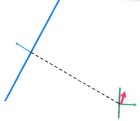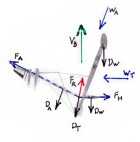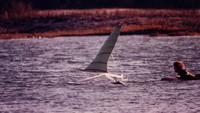High-Speed Sailing
| Vessel Name: | Sailien |
| Vessel Make/Model: | Experimental/custom |
28 September 2013
The America’s Cup
I watched, with interest, the videos of the 34th America’s Cup. At last we have fast sailboats engaged in a competition that is fun to watch. The virtual images (such as course boundaries, distance grid lines, separation between boats, etc.) overlaid on the real images really helps to keep the race [...]
31 August 2013
100 Knots for Hydroptere?
The latest news from Hydroptere is that they have plans for a 100 knot sailboat. This was posted on 26 Aug 2013, so look for that date at this address. http://hydroptere.com/en/the-news/last-news/
17 November 2012
Aptly named Sailrocket, blasts off!
While yet to be ratified, Sailrocket posted an average speed over 500 meters of 59 knots. I will not be surprised if they increase their record into the 60 knot range during this record attempt.
02 January 2012
More drag for VSR2?
I want to start by pointing out that the whole VSR2 team has done a stellar job and has demonstrated conclusively that the forces that drive a sailboat can be aligned for roll stability without using ballast and without using any down-force. (Trifoiler achieved roll stability by using down-force, but [...]
18 December 2011
My analysis of Sailrocket
I copied a diagram of VSR2 (wing doesn’t show well) and added in the major force arrows that apply. Be aware that these arrows are not correct in terms of scale (length) and some of their locations are guesses, however I believe I’m correct enough for us to learn something about what VSR2 has been [...]
23 October 2011
60 is within reach, what’s next?
I have been watching Sailrocket’s progress with great interest and there’s no question they have a winner. I fully expect to see them reach 60kt in the near future. Sailrocket has now demonstrated what I first learned with my models and again with my full-sized prototypes, that if you get the forces [...]
More on Sailing Faster than the Wind
"What I still don't fully understand is the "squeezing-effect" you mention in the analogy with the soap bars. I understand the soap experiment but I have trouble translating it to the case with the squeezing wind and water. I would be very grateful if you could develop this analogy in greater detail."
First let me state that my understanding of this is based on my own observation and analysis. The material I've read on the subject of sailing faster than the wind has been somewhat complex and not very clear; I hope the following helps us to understand this better.
I'm going to go back to the soap bar and expand out from there. Those of you that read my earlier posts on this will recall that if we take a bar of soap, cut it to make a wedge, moisten it and squeeze it between our fingers it will shoot out faster than our fingers are moving together. (Please refer to my posts "Faster than the Wind" - 5 May 08, and "Efficiency and Speed" - 6 May 08 for more info.) We can see and measure that a slower motion (our fingers) can produce a faster motion (the soap). I recommend that you try this as it will help to make that point real (not theoretical) to you. There are other examples that most of you are familiar with in which a slower motion can produce a faster motion. For example when you run, you push your feet back against the ground and move forward; note that you can only go as fast as you can move your feet. However if you put on a pair of skates (ice, roller, or inline) and you push the skate at an angle to your direction (the normal skating motion) you can move much faster than you can move your feet. This is the same relationship as the soap bar. Are you with me so far?
Let me state this before I continue. Do not believe anything I say, a book says, a professor says, etc. unless you can establish the workability of it for yourself. If it's not true for you, don't buy it. This is why I'm suggesting you play with the soap and go skating, besides, it's fun.
So how do we correlate this to sailing in the real world? In it's basic simplicity (in terms of propulsion), a sailboat is an airfoil (sail or wing) and a hydrofoil (keel, centerboard, fin, etc.) The rest of the sailboat is floatation and crew platform, interconnecting structure and controls but we can ignore all of that. You really don't need to know anything about a sailboat (other than airfoil and hydrofoil) to understand the ideas I'm trying to get across. If you are lucky enough to get ahold of Bernard Smith's book "The 40 Knot Sailboat" it has an excellent description of this. Also see my Sailien video.
Here we go. Take a soap bar and cut it so one long narrow side is thinner than the other long narrow side (the larger sides are now not parallel). Stand it up on one of the small ends, this is your sailboat and again if you squeeze the sides it will move away from the thinner narrow side. If you put one finger high on the soap (force on the sail) and the other finger low (force on the keel) and squeeze, you will probably topple the soap. The normal sailboat remedy is to put lead in the base of your soap (monohull) or install outriggers (multihull). Your fingers on the soap represent the forces generated by the wind and water acting on any sailboat (no matter what type). However your fingers do not represent the direct force of the wind or water and this is where it gets a bit less obvious.
Probably all of us have put our hand out the window of a moving car. (Likely got scolded too - a suppression of pure scientific research.) Note that if your palm is facing the air-stream, it will be forced back. This is the equivalent of sailing down wind. However, if you rotate your hand so the thumb is forward (fingers together, hand flat) and angle it so it is slightly upward, your hand will be forced up. If you angle it slightly downward, it will be forced down. That up or down force is the force generated by an airfoil or hydrofoil and is normally called lift, it is also sometimes called the resultant force, because it is the force that results when a foil moves through a fluid. This resultant force (lift) is what we are working with when sailing. Note that the resultant is roughly perpendicular to the foil. This resultant is the equivalent of your finger pushing against the tapered soap.
Please let me know if this is clear enough to translate the soap analogy to the forces driving a sailboat. I plan to continue and develop this idea further, but I want to know if it makes sense so far.
Bob
About & Links
- Bob's Surfing Blog
- Bob's Website
- Greenbird (Windjet)
- l'Hydroptere
- Le Projet Dared
- Macquarie Speed Sailing Team
- Monofoil Sailing
- Mountain Goat STOL
- Mr Smith's Amazing Sailboats
- Patent Office (Search)
- Radboat
- Sailien Prototypes (early), Delta, etc.
- Sailien Video
- Sailien Website
- The Basics of Surfboard Design
- The Basics of Surfboard Design en Espanol
- The Swedish Speed-Sailing Challenge
- Trifoiler
- Vestas Sailrocket
- Windjet Project
- WSSRC


